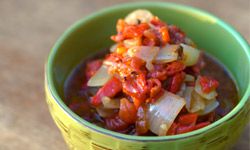 “Once you know how to read it, food labels can navigate you to a healthier lifestyle. See more food pyramid pictures.C. Sherburne/Photodisc/Getty Images
“Once you know how to read it, food labels can navigate you to a healthier lifestyle. See more food pyramid pictures.C. Sherburne/Photodisc/Getty Images
If you want a quick and easy cheat-sheet to help you take control of your diet, start reading food labels. Designed to provide you with valuable information about the foods you buy, food labeling can look confusing, but after a short primer, you’ll be reading your way to a better diet.
One of the best skills you can develop in the quest for a healthier lifestyle is an understanding of which nutrients you should be bulking up on and which ones you should be limiting. Although food labels may look like a high school science tables, they’re really an ingenious way to explain the constituents of a food product so that you can quickly understand how the information relates to you.
Start at the Beginning
The U.S. Food and Drug Administration (FDA) structures nutritional facts panels into easy-to-understand sections based on a daily value (DV) of 2,000 calories. Working from the top down, the label defines what constitutes a serving size for the product in both an intuitive quantity description, like per slice, cup or piece, and then by metric measurement. Below that is a handy listing of calories per serving as well as a breakdown of how much fat is represented in the calorie count.
This information will help you start to understand what impact a serving of the product will have on your daily diet and whether or not you want to "spend" part of your allotment of calories and fat on that food. Worried that the figures really don’t relate to you because you’re not within the 2,000-calorie base for the sample? Just make a quick mental adjustment for your actual calorie intake. A down and dirty guess will get you in the ballpark and help you decide if those cookies are really worth the investment.
Good vs. Not So Good
The next section shows specific quantities and percentages for things like fat and sodium. These are nutrients that should be limited in your diet, like cholesterol, or which have no established daily value guidelines, like sugar and protein.
Next is a list of nutrients that you should make sure to include in your diet, like vitamins and minerals. The FDA only requires manufacturers to list values for vitamins A and C, calcium and iron, but many manufacturers include more if their products are nutrient-rich.
The percentages that you see at the right of the panel are an at-a-glance list of how much of your daily value for that nutrient a serving will provide. A value of 5 percent or less is usually considered low, and a value of 20 percent or greater is considered high. When targeting your intake, aim high for nutrients that are good for you, and aim low for nutrients that have questionable value or should be limited, like saturated fat [source: FDA].
Footnotes
If the package size is large enough to include it, nutritional food panels have a bottom section for footnotes. Footnotes are always the same and will show recommended daily dietary values with a notation of whether the levels are minimums or maximums.
Exceptions
Although most prepared foods, as opposed to single ingredients and raw products, are required to carry nutritional labels, there are a few notable exceptions:
- Restaurant food
- Food service vendors and vending machines
- Airline food
- Medical food preparations
- Flavorings
- Spices
[source: Medline Plus]
Did You Know?
For a quick way to evaluate a packaged food item, take a look at the ingredient list. By law, packaged foods must list ingredients in descending order by weight. A quick peek at the first few items on the list will tell you a lot about how healthy a food is for you.
Lots More Information
Related HowStuffWorks Articles
- How Cholesterol Works
- How Fats Work
- How MREs Work
- What is sodium nitrate? It seems like lots of meats contain it. Is it in any way harmful?
Sources
- American Dietetic Association. " Shop Smart – Get the Facts on Food Labels." 2009. 7/27/09.http://www.eatright.org/ada/files/Shop_Smart.pdf
- Medline Plus. "Food Labeling." Undated. 7/28/09.http://www.nlm.nih.gov/medlineplus/ency/article/002459.htm
- U.S. Food and Drug Administration. "Food Labeling Guide." 11/04. 7/26/09.http://www.fda.gov/Food/GuidanceComplianceRegulatoryInformation/GuidanceDocuments/FoodLabelingNutrition/FoodLabelingGuide/default.htm
- U.S. Food and Drug Administration. "How to Understand and Use the Nutrition Facts Label." 11/04. 7/26/09.http://www.fda.gov/Food/LabelingNutrition/ConsumerInformation/ucm078889.htm
- U.S. Food and Drug Administration. "New Tools to Help Consumers Use the Nutrition Facts Label for Healthy Weight Management: Make Your Calories Count Program and Nutrition Facts Label Brochure, Questions and Answers." 5/5/09. 7/28/09.http://www.fda.gov/Food/LabelingNutrition/ConsumerInformation/ucm122080.htm














































